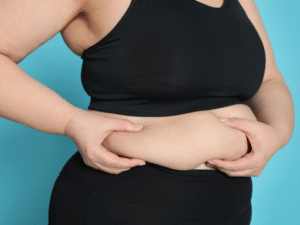Surgeons do not widely use gastric lap band surgery due to the availability of newer, more effective, non-surgical reversible alternatives that offer greater weight loss potential with fewer complications. Eventually, lap bands require removal. At IBI Healthcare, we specialize in determining the most suitable next step for Lap Band Removal and Conversion.
What is Gastric Lap Band Surgery?
The alternative term for gastric lap band surgery is adjustable gastric band surgery, a procedure that surgically places a restrictive device around the top part of the stomach to reduce a patient’s meal intake.
How Does a Gastric Lap Band Help Patients Lose Weight?
The gastric lap band positions a belt-like device around the upper part of a patient’s stomach to create a small pouch that can hold only a limited amount of food.
You can inflate or deflate the band to adjust the size of the pathway between the pouch area and the rest of the stomach. This helps the patient feel full faster and limits the amount they can eat at one time.
Why Would a Gastric Lap Band Need to be Removed?
All patients will eventually require surgery to remove their gastric lap band. The lap band does not last forever, and sometimes patients undergo early removal of their lap band due to complications. The success rate of lap band surgery is around 25% which is significantly less effective in comparison to other bariatric surgeries. Some of the reasons that would lead to the removal of a lap band are:
Inadequate Weight Loss
Lap band surgery kickstarts a journey requiring commitment and lifestyle adjustments. Adherence to changes in diet and exercise hugely influences weight loss success. However, only a small fraction of patients who undergo the surgery achieve and sustain significant weight loss.
Intolerance to or Complications from the Lap Band
The medical community considers lap band surgery as minimally invasive and often reversible without issue. After surgeons insert a lap band, approximately 50% of patients experience ongoing negative side effects that diminish their quality of life and prompt them to seek removal. Some of these side effects include:
- Nausea.
- Vomiting.
- Esophageal dysphagia – the feeling that food is stuck in the chest or bottom of the throat after swallowing.
- Esophageal Dilation and Damage.
- Aspiration at night can cause pneumonia.
- Band slippage:
- Erosion – lap band rubs a hole in the stomach.
- Chronic heartburn due to acid reflux.
Lap bands are not lifetime devices
Medical devices are manufactured from silicone and are not meant to be lifetime devices. The general rule is that they may last up to 10 years. If not removed at or before this 10-year mark, the lap band can begin to break down or become attached to the body possibly requiring a thoracic surgeon and a very complex surgery.
When is it Time to Remove a Gastric Lap Band?
If a patient starts encountering negative complications or side effects, removing the gastric lap band will provide immediate relief. The patient can infer that the gastric lap band is not an effective weight loss solution in situations where there is insufficient weight loss or weight regain, and should pursue another approach.
How is a Gastric Lap Band Removed?
The surgeon typically removes lap bands laparoscopically, and the procedure is usually uncomplicated unless there are extenuating circumstances.
The surgeon usually accesses the lap band through the initial surgical incision. Then, they proceed to remove any scar tissue that has formed around the band.
Firstly, the surgeon cuts the band and tubing to dislodge it from around the stomach. Additionally, they remove any supporting sutures that were placed during the installation. This process effectively restores the stomach to its original anatomy. The surgeon also ensures the removal of any scar tissue, reducing the likelihood of post-surgery obstructions and facilitating future revision or conversion surgeries.
If performing a conversion surgery the surgeon could proceed with that at this point.
Recovery After Gastric Lap Band Removal
Your Bariatric Surgeon will offer you aftercare instructions following the removal of your lap band, covering wound care, daily routines, driving, etc. You will need to keep your incision clean and dry to avoid infection. Usually, you can shower after about 48 hours.
You will notice that you feel hungry a lot more and this will elevate the potential and risk of gaining weight. To avoid gaining a significant amount of weight, you should have a plan in place before your lap band removal.
What Options do I have After Removal of a Gastric Lap Band?
Most patients will regain weight or stop losing weight unless the surgeon revises the failed lap band to another bariatric weight loss procedure.
Most patients chose to undergo gastric lap band surgery because it was the least invasive and easily reversible option. The patient can elect to use a surgical procedure for conversion or choose to use another non-surgical procedure.
a) Conversion to Another Bariatric Surgery
A gastric lap band can be converted to a surgical procedure such as a Gastric Sleeve, Gastric Bypass, or Duodenal Switch. All require surgery and associated recovery time.
b) Conversion to ESG
Today, endoscopic sleeve gastroplasty (ESG) is an optimal choice for lap band conversion. It provides a non-surgical alternative, offers comparable weight loss potential to vertical sleeve gastrectomy (gastric sleeve, VSG, or LSG), and is reversible.
Why Should I Convert Gastric Lap Band Surgery to ESG?
ESG is a bariatric weight loss procedure that does not require any incisions or a hospital stay. Patients can usually return home the same day.
The procedure is conducted through an endoscope that is lowered down the patient’s throat. Using special tools the surgeon reshapes the patient’s stomach into a small banana-shaped sleeve and secures it using about a dozen sutures.
Endoscopic sleeve gastroplasty works by making the stomach about 75% smaller which limits the amount someone can eat at one time. The smaller altered stomach takes longer to process food which makes the patient feel “full’ longer.
Recovery time from ESG is much faster than from surgery and patients can typically resume their normal routine in a few days. They can begin to incorporate physical activity earlier and all types of exercise after about one month.
Endoscopic sleeve gastroplasty (ESG) equals gastric sleeve weight loss, sans surgery, lengthy recovery, or permanence. The weight loss achieved with ESG relies on individuals’ dedication to a healthy lifestyle.
Schedule a Follow-up Consultation
If you’re facing complications or unsatisfactory weight loss after a lap band procedure, or if it’s been almost 10 years since the installation, IBI Healthcare Institute can assist you.
Contact us today for a consultation to explore options for lap band removal or conversion to another weight loss procedure. We prioritize your health and well-being and look forward to partnering with you for your best outcome.











